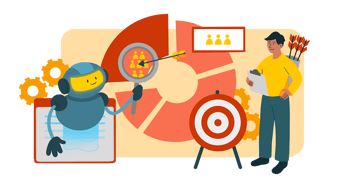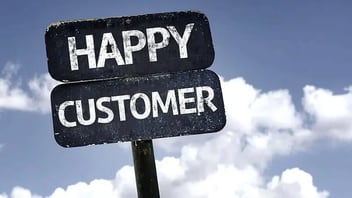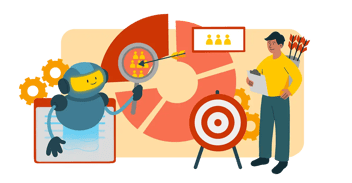Personalized Customer Experience: Key to Inbound Marketing Success
You know that ad you keep seeing while you browse news sites? The one for the accessory for the kitchen widget you bought online last week? Well, that's one simple example of what we're talking about here—to deliver personalized marketing.

Why Is an Inbound Customer Experience Relevant?
There is plenty of customer data to support positive customer feedback, higher customer satisfaction, and more loyal customers when dealing with personalized services along the customer journey:
-
90% of customers are willing to pay more for a better customer experience. Investing in your customer experience can lead to increased sales and revenue.
-
80% of B2B buyers start their buying process with a Google search. Optimizing your website and content for search engines is crucial to ensure potential customers can find your products or services when searching online.
-
80% of consumers are more likely to buy from a brand offering personalized experiences: This emphasizes the immense potential of personalization. Your target audience actively seeks and rewards brands catering to their needs. (Epsilon, 2023)
-
71% of consumers find irrelevant content frustrating: Bombarding people with generic messages backfires. Personalized content shows you understand their needs, building trust and loyalty. (Salesforce, 2023)
-
70% of buyers are likelier to do business with a company that provides personalized experiences. Gathering and utilizing their data is crucial to providing customers with a unique and memorable experience. This can range from personalized emails to tailored product recommendations or exceptional customer service.
-
Companies focusing on customer experience achieve 60% higher profitability: The link between personalization and revenue is undeniable. Investing in a customer-centric approach drives bottom-line growth, making it a worthwhile pursuit. (Aberdeen Group, 2023)
-
59% of B2B marketers report increased conversion rates with personalized content: Personalization isn't just for B2C. Tailoring content to specific business needs and pain points delivers tangible results, driving leads toward conversion. (Demand Gen Report, 2023)
-
Customers with a positive experience are 52% more likely to recommend your brand to others. The experience your customers have with your brand significantly influences your reputation and how people spread the word about your business.
-
The average cost of acquiring a new customer is 5-25 times more expensive than retaining an existing customer. Focusing on keeping your existing customers happy is much more cost-effective than constantly acquiring new ones.
- Personalized email campaigns generate six times higher response rates: Email remains a powerful marketing tool, and personalization unlocks its full potential. Speaking directly to individual interests boosts engagement and action. (Campaign Monitor, 2023)
A successful Inbound Marketing Strategy is full of opportunities to customize and create personalized content across multiple channels to hit your target more squarely and reinforce their belief in your message and trust in your company. From emails that address your customer by name to ads like the one discussed in the intro, all the way to custom webpages appearing for different visitors to your homepage and personalized customer service experience with an anniversary note. And all of this is possible now using inbound marketing techniques and automation solutions.
It all starts with knowing your target audience, ideal customer profile, and buyer persona.
Start with your Subscription Email List
A "low-hanging fruit" of personalized marketing is your email list. It also happens to be one of the most powerful tools in your arsenal for making potential and existing customers feel a connection with your brand. And the place to start is by personalizing your opt-in email newsletter.
They gave you their contact info, don't misuse that trust.
When we talk about opt-in email marketing, we're talking about using the contact information site visitors gave you in exchange for access to gated content, the sign-up list from that last convention you had a booth at, and any other potential customers who have willingly given you their email addresses. That shows a level of trust between the customer and your company that you need to nurture and prove that you respect.
And you can do that by NOT inundating your list with boilerplate email newsletters, offers that don't apply to half of your list, or other generic content. Segment your list by filtering it down using demographics, geographics, or any other parameter your CMS offers. Now, you have smaller niche groups that can easily be targeted with more specific offers, updates on the piece of your industry they're interested in, and so on. The benefits of marketing segmentation and personalization efforts are many:
-
Higher open rates
-
Higher click-through rates
-
Higher conversion rates
For starters. This method also allows you to send fewer emails, cutting your overhead dramatically. And as a bonus, you may also see a lowering in unsubscribe requests because people only see email content that applies directly to them.
Do you open your email in the middle of the night?
Marketing email automation solutions (and there are many to choose from) also allow you to schedule when each segmented message is sent. That way, your London and your Los Angeles lists will receive their newsletter just in time for morning coffee instead of getting lost in the Monday morning inbox inundation.
This level of customization is easy on your end yet shows your subscribers that you genuinely care about them and their culture and that you will maintain that level of trust in all of your interactions. Having the From-field display a person's name, not a generic "No_Reply" email address, is also key. Use the manager of your department or the CMO; just be sure to ask permission first, and don't use their actual email as the return address!
To be sure your email marketing efforts are working, cross-check them with our FREE Email Marketing Checklist:
Target visitors who have already downloaded content
Some folks in your CMS database will be there because they requested access to gated content. That's a ready-made segment right there. Use your automation tool to send a follow-up email a week after this initial request with additional links to deeper dives into the same topics, reminders of upcoming webinars, etc.
Make Full Use of Your Website Cookies
Paying careful attention to any rules and regulations that dictate how tracking information can be used (like the GDPR in Europe), CMS tools like WordPress and Hubspot offer powerful ways to customize site visitors' experience. You can set up custom CTAs for visitors to direct them to content they don't already have or related to the last thing they clicked on.
You can also customize entire pages on your site. Similarly, Hubspot offers "smart content" that will rotate through preset options based on parameters you set and triggered by the cookie left the last time that person visited the site. These pages can also greet the person by name (if you also have their contact info in your CRM) and display content tailored precisely to their previously expressed interests.
Location, Location, Location
Geo-fencing is a technology that lets app makers target smartphone users with location-specific offers, ads, and content. Using the GPS locator in the user's smartphone, your app can send a push alert whenever they're near one of your retail locations with coupon offers or when they arrive at a venue where you have a convention booth. It's no surprise when Canada Goose sends me personalized recommendations with an email with snowy outfits when a snow forecast is on the horizon. A great example of using data to personalize the customer experience and talk to every customer as an individual customer.
Retargeting Lets You Tailor the Ads a Customer Sees
Recall the example we began with, that display ad for a widget accessory you see across multiple sites. That's an example of retargeting. Retargeting is a way of reminding people who have visited your site how much they loved it and welcoming them to a return visit for more great content, offers, etc.
Using those tracking cookies from above, retargeting allows specific visitors to see specific ads whenever they visit any site that participates in the retargeting ad network you belong to. This technique increases brand recognition and recall and reminds folks of your quality offerings. It also encourages them to remember how much your product benefits them and return for more.
Inbound marketing offers many ways to customize and tailor the experience your customers have when they do business with you or visit your website. The bottom line is this—people trust people.
Suppose you can connect with a potential customer or refresh the relationship with an existing one through personalized experiences such as those discussed today. In that case, you can turn a regular customer into a brand advocate and a trusting customer for life.











Leave a Comment